Parent page: Getting Familiar with the Altium Design Environment
Once a project is established design documents can be added, edited or removed from the active project. These operations can be performed within the Projects panel, which provides an organized view of the project structure and its constituent design documents. The panel's right-click context menus offer the majority of commands required for working with design documents.
Note that the presentation of documents in the Projects panel does not reflect how they are stored on the hard drive or elsewhere. The panel's contents can be considered as a logical representation of the project, whereas the physical location and organization of the document file storage (and its type) are up to you – the documents might be stored in a folder on your local machine or a LAN, and of course, hosted in a version-controlled repository provided by a basic Git/SVN VCS system or a fully managed system such an Altium Workspace.
Add or Remove a Design Document
The simplest way to add new design documents to a project is to right-click on the project name in the Projects panel and select Add New to Project from the context menu options. Alternatively, choose the required document type from the Project » Add New to Project sub-menu of the main menus to add a new document to the active project.
- If the chosen document type can have defaults specified on the Data Management - Templates of the Preferences dialog, the chosen document type will be created using that default as a template.
- The document is initially unsaved.

Add a specific or another type of document to a project.
Other types of project-relevant documents can also be added to a project, such as text files, PDFs, spreadsheets, etc. To do so, use the Add Existing to Project option (or the Project » Add Existing to Project command from the main menu of the active document's editor) and set the File Type drop-down list in the Choose Document to Add browser dialog to All Files (*.*) so all file types can be accessed.
To remove a document from the project structure, right-click on its name in the Projects panel and select the Remove from Project menu option or choose the Project » Exclude from Project command from the main menus. You will be prompted to choose:
- Delete File – to permanently remove the source document file itself.
-
Exclude from Project – to remove the project's link to that document (and not delete the source document file itself). If it is currently open in the design editor window, it will be removed from its parent project but remain open in the panel as a free document. If, however, it is not currently open in the design editor window, removal will effectively close it.
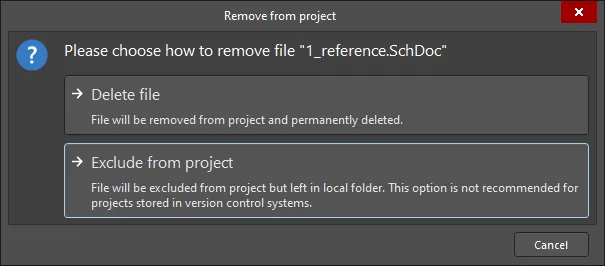
You can also remove all documents within the focused category (sub-folder) from their parent project by right-clicking on the entry for the required category and choosing the Remove All command, from the context menu.
To open an instance of Windows Explorer, at the location where a project document is stored, right-click its entry in the Projects panel and select the Explore command. For the document focused in the Projects panel, it can be done by clicking the  control at the top of the panel.
control at the top of the panel.
Opening a Document
To open a document, double-click it in the Projects panel or right-click its entry and select Open command from the context menu. Multiple documents may be opened simultaneously and each open document has its own tab on the Documents Bar at the top of the design window.
If you have enabled the
Opens and shows documents/objects option in the
Single Click region on the
System - Projects Panel page of the
Preferences dialog, then a single click on a document's entry in the panel will open it in the main design window.
You can also open documents as follows:
- By choosing the File » Open command from an editor's main menus (the
 button on the Quick Access Bar; shortcut: Ctrl+O). Any document that is opened this way will be opened as a free document (appearing in the relevant sub-folder of the Free Documents folder in the Projects panel) and made the active document in the main design window. Any project file that is opened will be added to the Projects panel and made the focused project.
button on the Quick Access Bar; shortcut: Ctrl+O). Any document that is opened this way will be opened as a free document (appearing in the relevant sub-folder of the Free Documents folder in the Projects panel) and made the active document in the main design window. Any project file that is opened will be added to the Projects panel and made the focused project.
- All documents within the focused category (sub-folder) in the Projects panel can be opened by right-clicking on the entry for the required category, then choosing the Open All command from the context menu.
- All schematic documents of the focused project can be opened by right-clicking on a Source Document folder that contains schematic documents, then selecting the Open All Schematic Documents command from the context menus.
- One or more documents, either in the currently focused project or all open projects in the active design project groups, can be opened by choosing the Project » Project Documents command from the main menus (shortcut: Alt+Ctrl+O).
After launching the command, the Open Project Documents dialog will open. Use this dialog to select the documents that you want to open. You can restrict the view to only list documents in the project that is currently focused in the Projects panel or all projects open in the active design project groups. Use the standard Windows shortcuts (Ctrl+Click and Shift+Click) to select multiple items from the list. With the required document(s) selected, clicking OK will cause those documents to be opened.
- All selected documents will be opened as tabbed document views in the main design window. The last document selected will be the last document opened, with its parent project becoming the active project (and also the focused project) in the Projects panel.
- To display the current status of documents in the Projects panel, click the
 button at the top of the panel, then enable the Open/modified status option within the Sorting grouping of pop-up controls. Alternatively, enable this option on the System - Projects Panel page of the Preferences dialog.
button at the top of the panel, then enable the Open/modified status option within the Sorting grouping of pop-up controls. Alternatively, enable this option on the System - Projects Panel page of the Preferences dialog.
Displaying Documents
Open Versus Active Documents
When you open a document, it becomes the active document. In Altium Designer, you are allowed to have as many documents open as you wish, however, only one document can be the 'active' document. The active document is open in the design space allowing you to make any required updates. The tab of the currently active document displays with a medium gray background; documents that are open and not currently active display with a charcoal gray/black background.

Right-click on any document tab to access a drop-down of commands to close the document on which you right-clicked, close all documents of the same editor (e.g., all PcbDoc, all SchLib, or all PcbLib documents) as the one on which you right-clicked, close all open documents, split, tile or merge documents.
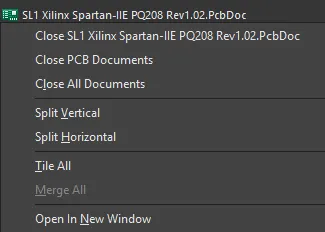
Open documents can also be closed from the following locations:
- an open document can be closed by right-clicking on its entry in the Projects panel and choosing the Close command from the context menu.
- the active document can be closed by choosing the File » Close command from the main menus (shortcut: Ctrl+F4).
- all currently open documents associated with the active project can be closed by choosing the Project » Close Project Documents command from the main menus.
- all currently open documents associated with the focused project in the Projects panel can be closed by right-clicking on the entry for the required project and choosing the Close Project Documents command, from the context menu.
- all open documents within the focused sub-folder in the Projects panel can be closed by right-clicking on the entry for the required category (sub-folder) and choosing the Close All command, from the context menu.
- all currently open documents in the current Design Project Group can be closed by choosing the Window » Close Documents command, from the main menus.
- all currently open documents and projects in the current Design Project Group can be closed by choosing the Window » Close All or File » New » Design Project Group command, from the main menus.
The entry of a free document will be removed from the Projects panel upon closure.
To make another open document the active document, click on its tab. Alternatively, use the Ctrl+Tab or Ctrl+Shift+Tab keys to cycle forward or backward (respectively) through all open documents, in accordance with the order in which they were originally opened.
If the
Ctrl+Tab switches to the last active document option is enabled, on the
System - View page of the
Preferences dialog, the functionality of this shortcut is overridden, and using it will simply switch between the currently active document and the previously active document.
The list of currently open documents is also available from most editors, at the bottom of the main Window menu (the documents are listed in the order that they were opened). Up to a maximum of nine documents can be accessed in this manner. Use a command to make the indicated, open document, the active document in the main design window.
If you have a large number of documents open, you can choose to group them by enabling the Group documents if need option in the Documents Bar options on the System - View page of the Preferences dialog. Documents can be grouped by document kind or by project. Documents grouped by document kind are sorted alphabetically in a grouped tab. Documents grouped by project are sorted alphabetically within each document kind sub-group in a grouped tab.
You can also toggle the display of the current document's editor (in the schematic editor, schematic symbol editor, PCB editor, PCB footprint editor, CAMtastic editor, and SimView editor) between maximized and not maximized by choosing the
View » Full Screen command, from the main menus or using the
Alt+F5 keyboard shortcut. Using this command, any docked panels will be hidden from display, as well as the application's main banner. Literally, all you see is the editor for the document itself.
Document Window Management
With Altium Designer, you are not limited to viewing and working with a single design document at a time. Various commands are provided that allow you to effectively manage the open documents and tailor their display to your preferred working habits.
Right-click on a document tab to access various commands for managing the document. These commands include those affecting the display of all open documents within the main design window, as shown below. Commands for splitting the main design window vertically (Split Vertical) or horizontally (Split Horizontal) are invaluable when performing cross-document tasks, such as cross-probing between a schematic and its PCB.
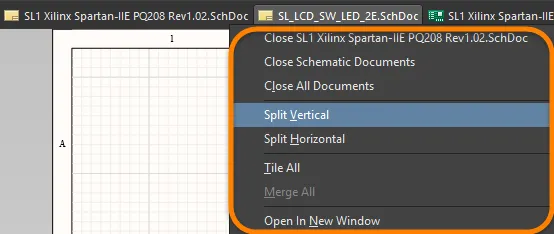
When split, the regions are treated as though they are individual windows. One document may be active in each region, but only one document, across all regions, can have the focus at any given time. When a new document is added, or an existing document is opened, it will be opened as part of the region in which the currently focused document resides. The image below shows the design space split vertically; the highlighted schematic document is the currently active document.
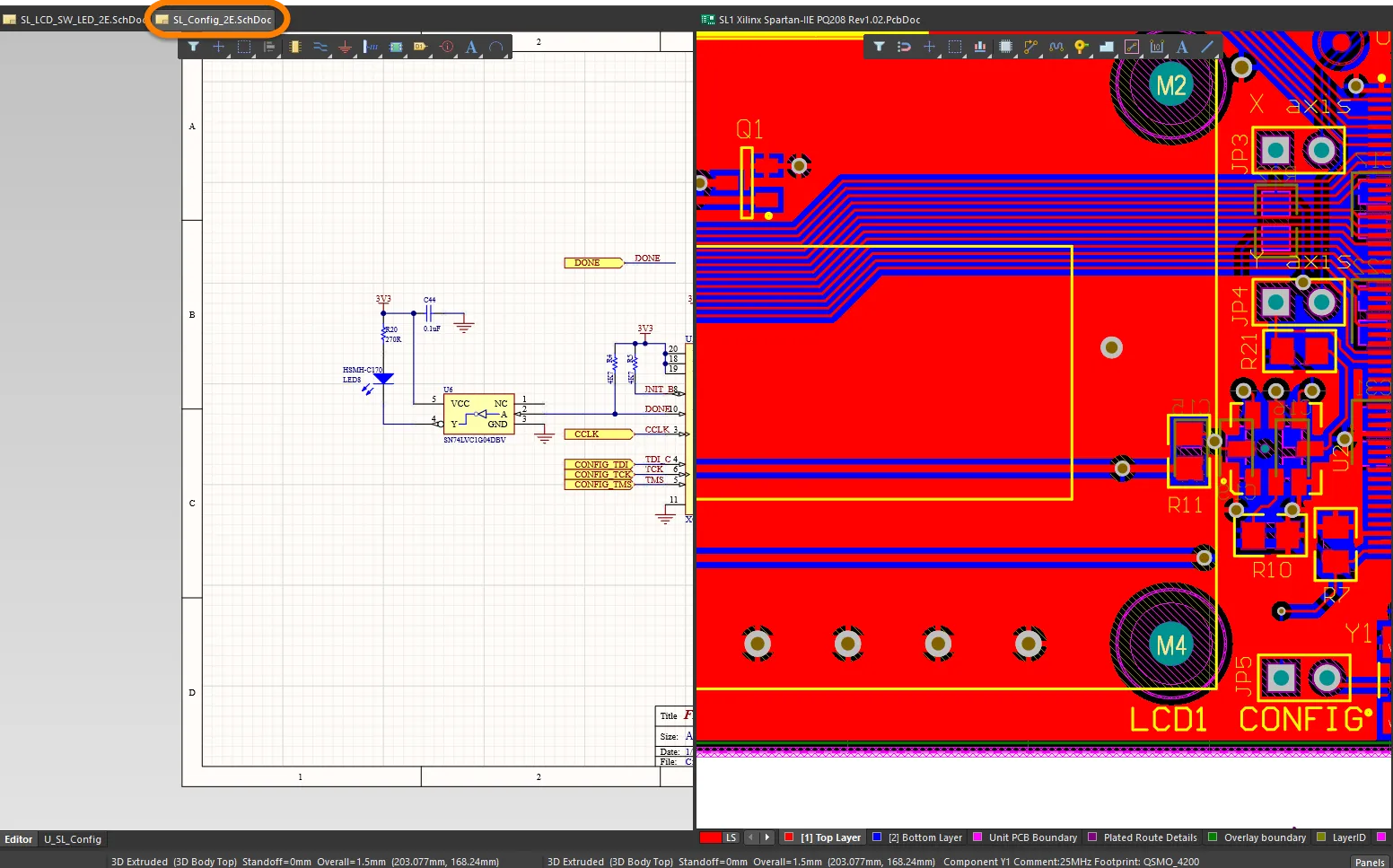
The right-click commands also allow you to tile the documents (Tile All, shortcut: Shift+F4), which opens each document in the design space as shown in the below image. In the image, the highlighted PCB document is the currently active document.
- Opening a subsequent document after using this command, will place it as a new tab in the currently active region. Run the command again in order to place this newly-opened document in its own tiled region.
- You can also use the Window » Tile Horizontally and Window » Tile Vertically commands accessed from the main menus of most editors to present all open design documents in their own individually, horizontally- or vertically-tiled regions, within the main application design window.
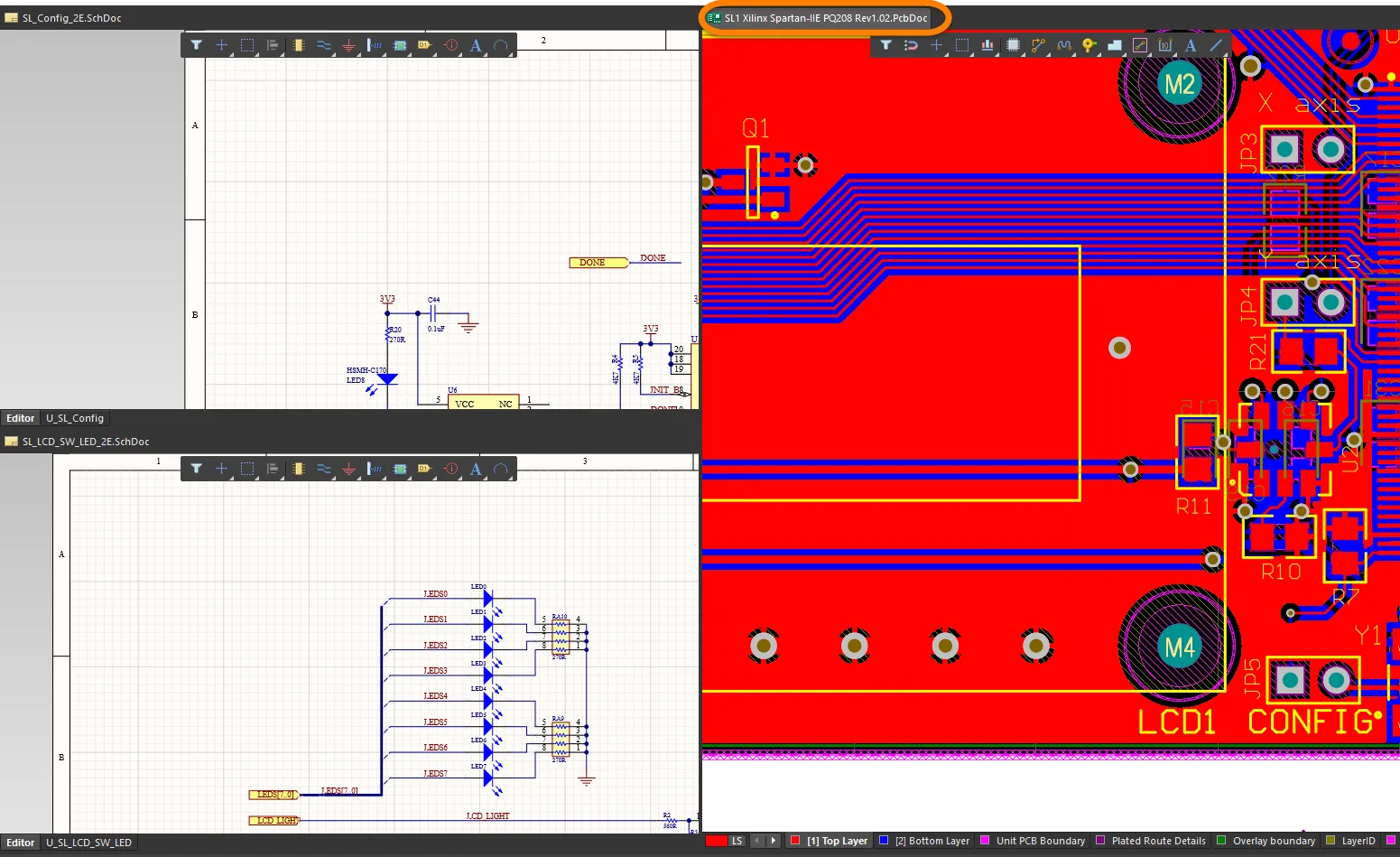
When documents are split or tiled, you can drag and drop them to another region.
Use the Merge All command to 'merge' all documents back into a single design window.
You can also open a document in its own separate design window by right-clicking on its tab then choosing Open In New Window from the menu or by clicking on its tab and dragging it to a point outside of the current Altium Designer window.
Altium Designer also provides a visually orientated project navigation aid –
Design Insight – that applies to individual document entries in the
Projects panel – as a
Document Insight. Refer to the
Document Insight section of the
Navigating a Project page to learn more.
Altium Designer Window Management
When multiple Altium Designer windows are opened, you can use the Window » Arrange All Windows Horizontally or Window » Arrange All Windows Vertically command from the main menus to arrange all Altium Designer windows on the desktop horizontally or vertically, respectively, so that they are all visible and do not overlap. After launching the command, all Altium Designer windows that exist on the desktop and are not minimized will be tiled horizontally/vertically, allowing you to see all windows at once.
- If you have multiple Altium Designer windows displayed across multiple monitors, all windows will be moved to the monitor displaying the Altium Designer window in which this command is launched.
- If you restore a currently minimized Altium Designer window, immediately after running this command, it will be tiled horizontally or vertically accordingly.
Navigating a Document
When working with a graphical document, such as a schematic sheet, PCB document, or Draftsman document, you can zoom and pan the document to focus on a specific document area. The basic shortcuts that can be used to do this are:
- Ctrl+Mouse Wheel to zoom in and out
- Right-Click, Hold&Drag to slide the document around
The View main menu includes a number of commands that can be used to control the view of the current document.
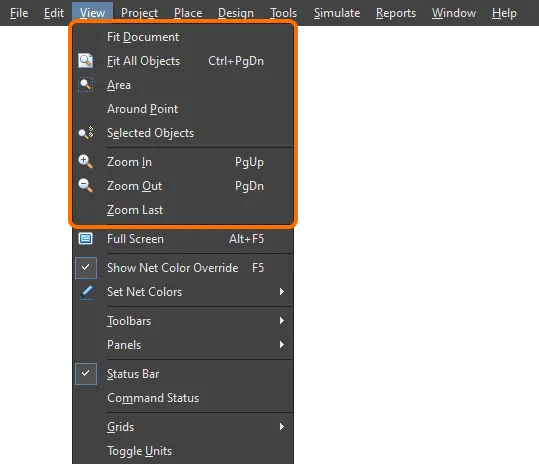
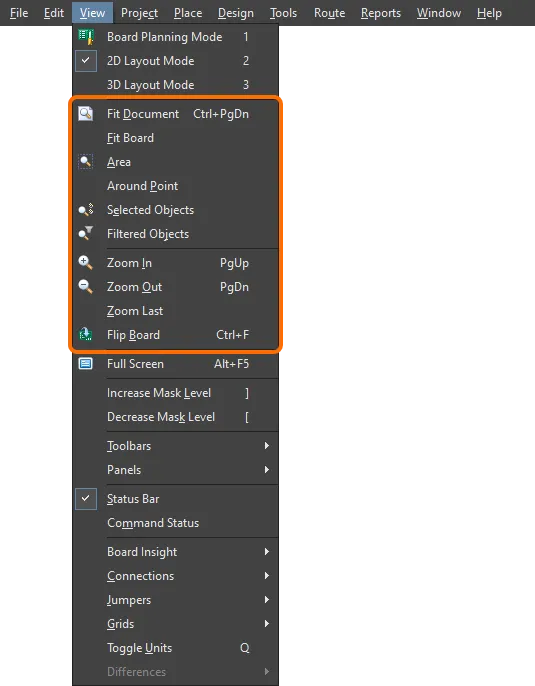
Use commands of the View main menu to control the view of your document. In the top image, the View menu of the schematic editor is shown. In the bottom image, the View menu of the PCB editor is shown.
These commands include:
- Fit Document - display the entire area of the current document.
- Fit All Objects - display all design objects on the current document.
- Area - zoom into a user-defined area of the current document.
- Around Point - redefine the display area about a specified point in the current document.
- Selected Objects - change the view in the design space, such that all selected objects are visible.
- Zoom In - bring the design closer to you, relative to the cursor position, in the current document.
- Zoom Out - move the design away from you, relative to the cursor position, in the current document.
- Zoom Last - return the display to the previous view of the screen, in the current document.
Jump to Location
Using the commands of the Edit » Jump sub-menu from the main menus of the schematic, schematic symbol, PCB or PCB footprint editor, you can jump to a specific point in the active document. For example, you can jump to:
- the document's origin coordinate (for a schematic sheet, the origin point corresponds to the bottom-left corner);
- any location within the current document, based on user-specified XY coordinates - select the Edit » Jump » New Location command to enter values for the X and Y coordinates within the design space, for the location you wish the cursor to jump to, in the Jump To Location dialog that appears;
- an object within the document. Use the following commands to jump to an object of interest:
-
a component on the schematic sheet - Edit » Jump » Jump Component. After launching the command, the Component Designator dialog will appear. Enter the component designator for the component you wish to jump to. If the designator is valid and the component exists on a schematic source document within the active project, then the relevant schematic document will be made the active document, and the target component will be zoomed and centered (where possible) within the main design window.
When targeting a multi-part component, only enter the root designator. Do not include the part suffix. For example to jump to a 2-part IC component, whose parts are designated
IC1_CPA and
IC1_CPB, enter
IC1_CP into the
Component Designator dialog. For a multi-part component, the first part will be highlighted, with the
Find Text - Jump dialog opened. Use this dialog to jump between sub-parts of the component.
Enable the Physical option in the Component Designator dialog to confine the jump feature to only physical component designators - those appearing on the Compiled Document tabbed views of the source schematic documents, after the project has been compiled. With this option disabled, the jump feature will only consider logical designators - those appearing on the Editor tabbed views of the source schematic documents.
-
a position in the current schematic or PCB document, whose coordinates have been previously stored in the indicated location marker - select the Edit » Jump » Location Marks » n command to jump to the position that has been stored in the indicated location marker using the Edit » Jump » Set Location Marks » n command.
A stored location is only available while the document remains open (active or not). If the document is closed and opened again, the location marker will be empty.
Indicating Document Status
As you work with project documents in Altium Designer, the Projects panel provides a visual summary of which document files are modified or saved through status icons that are associated with each design document, and the main project file. This provides a quick visual summary of which documents are modified, saved, whether they are Workspace or local, and their version control status. The document icons and meanings are listed below.
Open/Modified Status Icons
Note that the hover text will also report when multiple users are editing (or have edited) the shared document.
A modified document or project that has yet to be saved locally is distinguished by an asterisk next to its entry in the
Projects panel. Modified documents are also indicated by an asterisk inside their tab in the main editor window. When file locking is enabled (see
Data Management – File Locking), the icons associated with documents in the panel indicate when a file is open, modified, open, and locked by this instance of Altium Designer, or open and locked by another instance of Altium software. Regardless of file locking, a modified document is indicated by an asterisk associated with its file name.
Version Control Status Icons
The version control system essentially monitors and compares the files in the working folder to their counterparts in the design repository. Altium Designer both requests and exchanges information with the version control system via its VCS interface, and responds to the comparative file status conditions accordingly. In practice, this manifests itself in the Projects file icons, through a range of VCS alerts, and by appropriate changes in the available file management commands.
The icons and their meaning are as follows:
| [blank] |
N/A |
The file is not under version control in a VCS repository, |
 |
No modification |
The local copy of the file matches the file in the repository and is up to date. |
 |
Scheduled for Addition |
A file has been added to version control but not yet Committed (checked in) to the VCS repository. |
 |
Modified |
The local copy of the file has been modified and saved to the working folder. Commit the file to create a new revision in the repository. |
 |
Out of date |
The local copy of the file (in the working folder) is older than its counterpart in the repository and is therefore out of date. Use the Update or Update Whole Project command from the History & Version Control right-click menu of the Projects panel or the Projects » History & Version Control main menu to retrieve the latest file from the repository or save the file, which will create a Conflict condition. |
 |
Conflict |
The file has been committed by another user before you have committed your own edited and saved version of that file. Use the Version Control Update or Resolve command to determine which version of the file will become the latest revision in the repository. |
 |
Ahead of server (Git) |
The file in the local working repository is newer than its counterpart in the remote Git repository. This occurs when a local file has been modified, saved and committed to the local repository, but not yet Pushed to the remote repository. |
 |
Scheduled for Deletion |
The project file has been removed from version control and will be deleted from the VCS repository and database during the Version Control Commit process. This icon also appears when a file is missing from the local working folder (it has been deleted, renamed or moved), which is resolved by re-populating the folder from the repository with the History & Version Control » Update command. |
- Select the History & Version Control » Refresh option from the panel's right-click menu or select the Project » History & Version Control » Refresh command from the main menus (or press F5) to refresh the current VCS status of each file entry. It compares the files in the working folder to their counterparts in the design repository, refreshing the status of each document accordingly.
- Hover over a VCS icon to see a definition of its meaning.
- Click a VCS icon to receive more information on the VCS status of the document and access options to perform relevant actions.
Saving a Document
The currently active document can be saved locally by:
- Choosing the File » Save command, from the main menus.
- Clicking the
 button on the Quick Access Bar.
button on the Quick Access Bar.
- Clicking the
 button on the editor's main toolbar.
button on the editor's main toolbar.
- Using the Ctrl+S keyboard shortcut.
The currently focused document in the Projects panel (if the document is actually open) can also be saved by right-clicking on its entry in the panel and choosing the Save command, from the context menu.
The currently focused item (document, project, or project group) in the Projects panel can be saved by clicking the  button at the top of the Projects panel. When the focused item is a project, only the project document is saved. The constituent design documents are not saved by this command. When the focused item is the design project group, only the design Project Group document is saved (*.DsnWrk). The constituent projects and their design documents are not saved by this command.
button at the top of the Projects panel. When the focused item is a project, only the project document is saved. The constituent design documents are not saved by this command. When the focused item is the design project group, only the design Project Group document is saved (*.DsnWrk). The constituent projects and their design documents are not saved by this command.
A document in a modified state can also be saved by using the corresponding command from its document tab - right-click on the tab to access a context menu of commands. Note that this command will not be available if multiple documents of the same type are open and currently grouped.
For schematic documents, if the current file format is not Binary Version 5.0, the File Format dialog will appear, from where you can choose the format in which to save. It is recommended to choose the option to save in SCH Binary Version 5.0. If you have used features that were not available in previous versions of Altium Designer, saving in an earlier format may result in loss of data.
For PCB documents, if the current file format is not Binary Version 6.0, the File Format dialog will appear, from where you can choose the format in which to save. It is recommended to choose the option to save in PCB Binary Version 6.0. If you have used features that were not available in previous versions of Altium Designer, saving in an earlier format may result in loss of data.
An open project document can be saved under a new name using the File » Save As command or the Save As command from the right-click menu of the document entry in the Projects panel, which creates a copy of the document file under the nominated new name. This process automatically adds (links) the new document copy to the active project in place of the existing (source) document, which remains intact in the source folder. If the open document is not part of a project – a free document – the new copy is simply opened in the editor in place of the original document.
After launching the command, the standard Windows Save As dialog appears. Use this dialog to browse to a particular destination in which to save the file, give the file a new name (if required) and also to select the format in which to store the file (where available). The newly saved file will be opened in place of the original file as the active document.
The parent project must be saved in order to point to the copy of the document the next time the project is opened, otherwise the project will include the original document still.
If the intention is just to make a backup copy of a document, use the Save Copy As option. This creates a named copy of the document file without affecting its host project. After launching the command, the standard Windows Save A Copy Of dialog appears. Use this dialog to browse to a particular destination in which to save the file, give the file a new name (if required) and also to select the format in which to store the file (where available). The newly saved file will not be opened in place of the original file.
All projects and documents that have been modified can be saved by:
- Choosing the File » Save All command, from an editor's main menus.
- Clicking the
 button on the Quick Access Bar.
button on the Quick Access Bar.
- Right-clicking on the entry for the design project group in the Projects panel, and choosing the Save All command, from the context menu.
If the projects are part of an existing (previously saved) Project Group, and project membership has changed (projects added or removed since last save), then the Project Group document (*.DsnWrk) will also be saved.
To save all documents that are currently open within the focused category (sub-folder) in the Projects panel or descendant folders thereof, right-click on the entry for the required category (sub-folder) and choose the Save All command, from the context menu.
Managing Project Documents
Change Project Document Order
Documents in the Projects panel are automatically arranged in logical groups or 'folders', such as Source documents (Schematic, PCB, etc.), Settings documents (Harness, Outjob, etc.,) and in the case of a hierarchical design, top-level schematic documents. The documents within each folder group are displayed, by default, in the order they were added, but can be dragged and dropped to a new order position within the group.
In the case of a new hierarchical design, the parent-child relationship between documents will be displayed in the Projects panel. Note that the connectivity relationships cannot be defined by dragging and dropping schematic documents since the inter-sheet connections and design hierarchy are in fact defined by Sheet Symbols and Port definitions.
► For more information about project hierarchy, see Creating Connectivity and the Net Identifier Scope section in the Options tab of the Project Options dialog.
Document Renaming
You can directly change the name of any of PCB project constituent design files (*.PcbDoc, *.SchDoc, etc.), the PCB project itself (*.PrjPcb) or the project group (*.DsnWrk) by using the Rename command – available from the right-click context menu for a project in the Projects panel.
 Examples of renaming a project and one of its design files, locally from within Altium Designer. Those changes will be synchronized with the Workspace when you save and send the changes to that Workspace.
Examples of renaming a project and one of its design files, locally from within Altium Designer. Those changes will be synchronized with the Workspace when you save and send the changes to that Workspace.
With renaming performed, save the changes to the Workspace using the Save to Server command (available from the same context menu for the project). File rename synchronization is maintained between the local working copy of the project and its counterpart in the Workspace. Additionally, when the project file name has been renamed and the project saved to the server, the Workspace automatically changes the managed project's Name parameter to match.
Conversely, when the name of a managed project is updated through the Workspace's browser interface, the change is propagated to Altium Designer when the project is next opened.
To edit the properties of an existing managed project in the Workspace, select its entry on the
Projects page, click the

control above the listing of projects, and choose the
Edit entry on the associated menu. Change the name for the project in the subsequent
Edit Project window that appears.
When the updated project is opened in Altium Designer (File » Open Project), an initial dialog provides the option to align the local project file name with the new project Name, or force the server project Name to match the existing project file name.
 Options available if you have renamed the project on the Workspace side.
Options available if you have renamed the project on the Workspace side.
Share Documents Between Projects
Because an Altium Designer project defines and saves links to stored document files, any number of projects can be created that link to those same document files.
While this may be a convenient way to re-use established design documents – say, including a standard power supply schematic in several projects – it is not recommended practice because a change in the document will affect all projects it is linked to. A far better approach for design reuse is to establish and apply Managed Sheets.
► For more information about design document reuse and Managed Sheets, see the Managed Sheets page.
Compare Local Documents with Commit or Release Data
For projects hosted by an Altium 365 Workspace, you can compare locally saved schematic and PCB documents with the data of a commit or release of this project. Commands for selecting a required data set with which the local documents should be compared can be chosen from the following locations:
When the Latest Commit or Latest Release command is selected, the project data comparison with those from the latest commit/release entry will start. When the Select Commit or Release command is selected, the Project History view will open for the selected project. Select the tile of a commit or release to compare the locally saved data with the data of this commit/release.
Once complete, the comparison results are presented in the Compare view, which opens as a new tab in your default browser.
To learn more about design data comparison features provided by the Altium 365 Workspace, see
Design Data Comparisons.
Clipboard Panel
To store and display copied objects that can be added (pasted) to Altium Designer documents at any stage, allowing for multiple copy/paste operations, the Clipboard panel can be used.
 View and apply (paste) Clipboard panel content for all design data types.
View and apply (paste) Clipboard panel content for all design data types.
To access the panel, the
Value field for the
UI.PanelClipboard Preference Name on the
Advanced Settings dialog must be enabled (it is disabled by default). The
Advanced Settings dialog is accessed by clicking the
Advanced button on the
System - General page of the
Preferences dialog. If any changes are made in the
Advanced Settings dialog, the software must be restarted in order for the changes to take effect.
Clipboard Panel Contents and Use
Panel Contents
The Clipboard panel supports a variety of data formats depending on the origin and object type. It can be set to display either only objects copied or cut from within the Altium Designer environment, or the entire Windows clipboard (this setting is accessed through Preferences on the System - General page of the Preferences dialog). Note that not all data types are supported by each design editor (PCB editor, schematic editor, etc.).
The data types supported are:
- Any design object copied or cut from a schematic-based (schematic/schematic library) or PCB-based (PCB/PCB library) document.
- Uni-code text copied or cut from any text-based document (e.g., text file, scripting file, constraint file, Microsoft Word/Excel document, etc.).
- Bitmap images created from 3D view modes for pasting into other applications.
- Windows enhanced meta-file image formats (e.g., simple bitmap images/text cut/copied from Microsoft Word/Excel documents). This data type is supported in the PCB editor only.
Panel Use
As objects or text are copied/cut; a matching entry will appear in the main list area of the panel in their native formats - that is, graphics or text.

To paste an item into the active document in the design editor window, click on the item in the Clipboard panel. The nature of the paste depends on the object being pasted and the target document type as described below:
- When pasting schematic-based or PCB-based objects into a document, the object will appear floating with the cursor. Position the object as required in the workspace and click to place.
- When pasting text into a text-based document, the text will be placed at the current cursor position in the document.
Use the Paste All button at the top of the panel to paste all objects in the panel into the active document. Again, the nature of the paste depends on the target document:
- The target document will only paste compatible objects to the document type. Each object in the panel will appear floating, in turn, on the cursor in the main design workspace. Place each object at the desired location and click to place.
- When pasting into PCB documents, if the object is re-sizeable, handles will appear that can be dragged to resize. Right-click to enable the resizing and progress to the next pasting object.
- When the target document is text-based, only text entries will be pasted. Each text entry in the panel will be pasted, in order, starting from the current position of the text cursor.
Right-click over an entry in the panel to open a context menu allowing you to either paste that entry or delete it.

To delete all current entries from the panel, click the Clear All button.
Notes
- You can only paste objects from the panel if they are supported in the target document that is open (the active document) in the design editor window. For example, if you try to paste a schematic-based object into a text-based document, there is no result, and vice versa.
- Text objects copied to the panel will appear as though they are unformatted. However, when pasted they will appear with the original formatting that existed before they were copied.
- It is advisable to place the text cursor in the required position before pasting text from the panel into a text-based document.
- When using Paste All to paste multiple text entries into a text-based document, the pasted text will, in effect, be concatenated - that is, each subsequent text entry is pasted immediately after the last.
- Clipboard panel content is not persistent across design sessions. All content will be cleared when the software is closed and restarted.